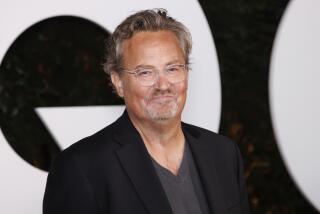Canadian Inquiry Told of Bizarre Medical Practices
- Share via
TORONTO — After 60 days of testimony, the Canadian government’s commission of inquiry into drug use by athletes already was all too aware that athletes in a wide variety of sports use banned drugs to enhance their performances.
Even when Robert Kerr, the San Gabriel sports-medicine doctor whose expertise in the subject of anabolic steroids is recognized worldwide, testified Monday that he administered the drugs to 20 athletes in the early ‘80s who later won medals at the 1984 Summer Olympics at Los Angeles, it did not create a stir among the now-jaded spectators in the hearing room.
But Kerr, 54, did not stop there. He also gave the commission an indication of just how far athletes and their coaches, doctors and pharmacists will go to gain an edge.
He mentioned testosterone from rams, nerve gas, strychnine, pig fetuses, the injection of air into the rectums and colons of swimmers to improve flotation, and muscle biopsies performed by surgeons to determine whether athletes have fast-twitch or slow-twitch muscle fibers.
The last revelations caused the commissioner, Ontario associate chief justice Charles L. Dubin, to interrupt.
“That sounds like the bionic man,” Dubin said.
“Or Frankenstein,” Kerr said.
Kerr was at one time blamed, or applauded, depending on one’s viewpoint, for acting as a creator of chemical athletes.
At the same time, he also created a reputation in the sports world unrivaled by any other doctor’s in the United States, even though he told the commission that he knew of 72 others in the Los Angeles area, among them four or five in San Gabriel, who treat athletes with banned drugs.
In his 1982 book, “The Practical Use of Anabolic Steroids With Athletes,” he said that he had treated more than 4,000 athletes from 20 countries. He said Monday that the athletes were from North America, South America, Asia, Europe and Australia. Whether he never treated athletes from Africa or he simply forgot to mention them was not clear.
Most of the athletes, he said, were power lifters and bodybuilders, but athletes in baseball, football, ice hockey, roller hockey, track and field, cycling and swimming also were represented.
Kerr, who frequented weightlifting gyms as part of his training as an amateur rugby player, said that he began prescribing drugs for athletes in 1966 because he was appalled to see them buying drugs from the black market.
“That seemed to me a rather bizarre way to take medications,” he said. “I thought medical doctors should try to put some sense into what was going on.”
He said that he quit 18 years later, a short time after the Los Angeles Olympics, having learned that no sense can be made of it.
He said that he would prescribe the drugs for athletes, tell them the dosages to take to avoid side effects and even monitor their health through laboratory tests. Although the quality of his care has been disputed by some former patients, Canadian sprinter Angella Taylor Issajenko testified earlier that she was satisfied he had her best interests at heart when he treated her in 1983.
“I felt the athletes could be trusted to some degree,” Kerr said.
But he learned otherwise. He said too many athletes over the years chose to supplement his treatment with drugs bought on the black market. No amount of counseling, he said, would dissuade them. The game had passed him by.
“Frankly, I was becoming old-fashioned to them,” he said. “I would have nothing to do with drugs that were not legal (to be sold by prescription) in the United States, and it was those drugs that the athletes wanted.
“Now, patients are advised that if they even mention the word steroids , that’s the end of our session.”
Kerr not only said that he quit treating athletes with steroids and other banned substances, it appears as if he joined the other side. He submitted to the commission an eight-page letter that he sent on March 1, 1985, to five respected sports-medicine doctors, including Robert O. Voy, who at the time was the U.S. Olympic Committee’s chief medical officer.
It was in that letter, much of which was read into the record Monday, that Kerr detailed the latest tricks of the trade as he had learned them from European doctors attending the Los Angeles Games. Compared to some of the methods for improving athletic performances mentioned in the letter, prescribing steroids seems not much worse than removing a splinter.
Naturally, Kerr’s continued communication with the doctors who are attempting to eradicate drug use in sports has made him suspect among his athlete-patients. Although he said he no longer prescribes steroids and other performance-enhancing substances, sports medicine still accounts for about 50% of his practice.
“They don’t discuss drugs with me as they once did,” he said. “They know I’ve been rather open with Dr. Voy. They’re rather hesitant about telling me what they’ve used.”
But he said that he does not believe drug use among athletes has diminished since 1984.
Quite the contrary, he said.
“It seems to me to have escalated over the years to ridiculous amounts, no question about it.”
More to Read
Go beyond the scoreboard
Get the latest on L.A.'s teams in the daily Sports Report newsletter.
You may occasionally receive promotional content from the Los Angeles Times.






